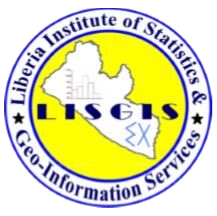The agricultural economy is mostly subsistence
and less monetized. We observed that one third
(30.2 per cent) of the total households in Liberian
are agricultural households, most of which are rural
residents. Also, there were more males than females
found in the agricultural households. At the same
time, about 0.5 per cent of the total population found
in agricultural households suffered at least one form
of disability.
About half (49.5 per cent) of the agricultural
household heads did not acquire formal education.
At the same time, 40.8 per cent of children
(ages 3-17) residing in agricultural households did
not attend school. Also, the total heads of agricultural
households practiced monogamous marriage is
63.9 per cent. About 85.3 per cent of the whole
agricultural household heads are Christian, while
11.2 per cent are Muslim. Also, the age group 35-64
is the highest age group of agricultural household
heads, while the age group 1-12 is the highest age
group of the population found in the agricultural
household.
Most agricultural households are engaged in arable crop farming, compared to tree crops and aquiculture farming. Fishery occupied the highest proportion (4 per cent) of the total agricultural households involved in animal husbandry. Knowledge of the health benefits acquired from consuming meat and chicken means that the size of various households needs to increase. The entire agricultural household lacks basic essential and non-essential amenities.
Agricultural Practices and Livelihoods
There were 7,193 agricultural communities sampled across Liberia’s fifteen counties. Most practiced rain‑fed temporary crop cultivation (72%). Market gardening was practiced in more than half of the communities (54.4%).
Community Development and Facilities
The majority of Liberia Agricultural communities, 68.8 per cent (4,952) did not experience any new developments within the past three years before the data collection. Among the communities that experienced new developments, the most commonly reported developments include the provision of on-grid electricity (30.9%), construction of new roads (22.9%), and establishment of new schools (22.2%).
Livestock and Poultry
Two in four communities reported practice of poultry or livestock rearing. Poultry activities took place in 32.6 per cent of communities. Goats and Pigs were the two main types of livestock raised in communities. About 27.3 per cent of communities raised goats while 25.1 per cent of them raised pigs. Only 8.1 per cent of livestock or poultry communities had vaccination campaigns.
Access to Markets and Services
There are 57.1 per cent of communities having direct access to primary school, 3.3 per cent have direct access to hospitals and 34.4 per cent of them have access to the same infrastructure (hospitals) when nearby areas are considered. Also, 15.3 per cent of communities have direct access to food market for purchase and sales.
Challenges in Agricultural Activities
Crop disease and animal damage are the two most challenges faced by farmers in the communities. About 53.9 per cent of communities reported that crop disease is a major challenge for farmers while 46.2 per cent of communities reported animal demage as a major challenge.

